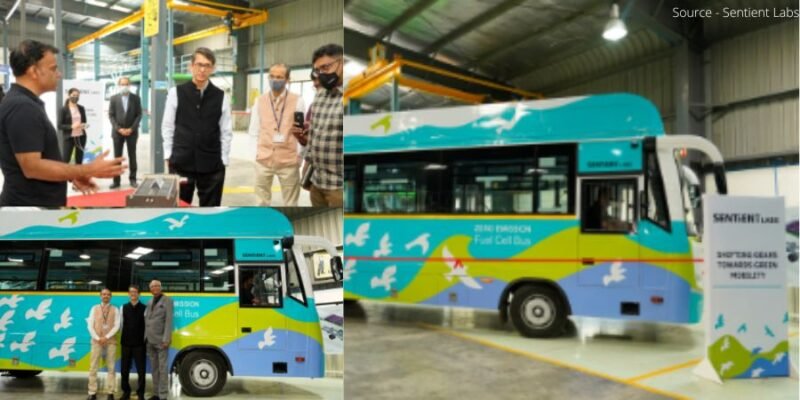Many brilliant inventions were made in 2022, as people throughout the nation visualized a better future and came up with ways to make it a reality. This never seen public transport bus, with zero emission of any harmful greenhouse gases, has been launched on August 21, 2022, by the Union Minister for Science and Technology, Dr Jitendra Singh in Pune.
About The No Emission Transport
This is India’s first zero-emission bus which uses HFC ( Hydrogen Fuel Cell ) technology which reacts with hydrogen and oxygen to generate electrical energy which eliminates the use of fossil fuels. Further, the fuel cell technology emits only water, thus cutting down the emission of air pollutants.
For public transportation, hydrogen fuel cell (HFC) technology which produces no emission is more appropriate. To operate conventional battery-electric buses within the specified range, a big battery is needed. HFC technology, in contrast, uses a lot smaller battery to provide a significantly larger operating range.

Makers of The Brilliant Innovation
This never before seen invention was made by an R&D and engineering company ‘Sentient Labs’ which pursues exciting and innovative technology solutions and develops cutting-edge, highly efficient solutions for the automotive and mobility industry. They develop technologies and offer them to the industry where their innovations can be adopted for production.

In addition to developing the zero emission hydrogen fuel cell technology in-house, Sentient Labs also designed and built the balance of the plant, the powertrain, and the battery pack. A 32-seat, air-conditioned bus measuring 9 meters long has all of these components installed. This is intended to have a 450 km range while only using 30 kg of hydrogen. The modular architecture permits design modifications to meet operational and range requirements.
Fuel cells use hydrogen and air to produce electricity, which powers buses. The bus may be the most environmentally beneficial means of transportation since all of its waste is water. In contrast, over a million diesel buses are operating on long-distance routes in India, with emission of an average of 100 tonnes of CO2 per year.
There are more innovations leading to a cleaner environment, Read about – Electric Boat Powered By Solar Energy
Benefiting The Country
Green hydrogen is an outstanding clean energy vector that permits extensive decarbonization of difficult-to-abate emissions from the refining business, like the fertilizer industry, steel industry, cement industry, as well as from the heavy commercial transportation sector.

This innovation can also act as a bridge between India and the other parts of the world helping it in becoming the net exporter of clean hydrogen energy. With the growth of hydrogen-fueled vehicles on the roads, the harmful emission of polluted gases can be eliminated and it will lead India towards a better and cleaner future.
What Are Hydrogen Fuel Cells?
With the fuel cell turning hydrogen-stored energy into electricity, FCEV propulsion is comparable to that of electric vehicles. Contrary to vehicles with conventional internal combustion engines, these vehicles don’t produce any harmful emission. Other advantages include boosting the economy and diversifying the U.S. energy supply to increase energy resilience.

Advantages of Zero Emission Fuel Cells
Zero emission fuel cells are powered by pure hydrogen gas that is kept on the vehicle in a tank. Similar to conventional internal combustion engine vehicles, they can be filled in less than 4 minutes and have a driving range of more than 300 miles.
Other cutting-edge technologies are used in FCEVs to boost efficiency, like regenerative braking systems that collect the energy lost during braking and store it in batteries. According to the capacity of the emerging infrastructure, major automakers are providing a small but growing number of production FCEVs to the public in a few markets.
Additionally, fuel cell trucks and buses have lower operating expenses per kilometre than diesel-powered vehicles thanks to the great efficiency of fuel cell vehicles and the high energy density of hydrogen.
To know more about the Zero Emission Fuel Cell, you can check – Sentient Labs
If you like this story, you can also check out – Man Quits His Job In Dubai, Works for 20 Years to Create 4800 Plant Species Biodiversity Park
Feature image source – Sentient labs
If you know about more inspirational stories about a person, company, new idea, or social initiative, and want us to write it on mad4india.com, share such information with us on Facebook or LinkedIn.



